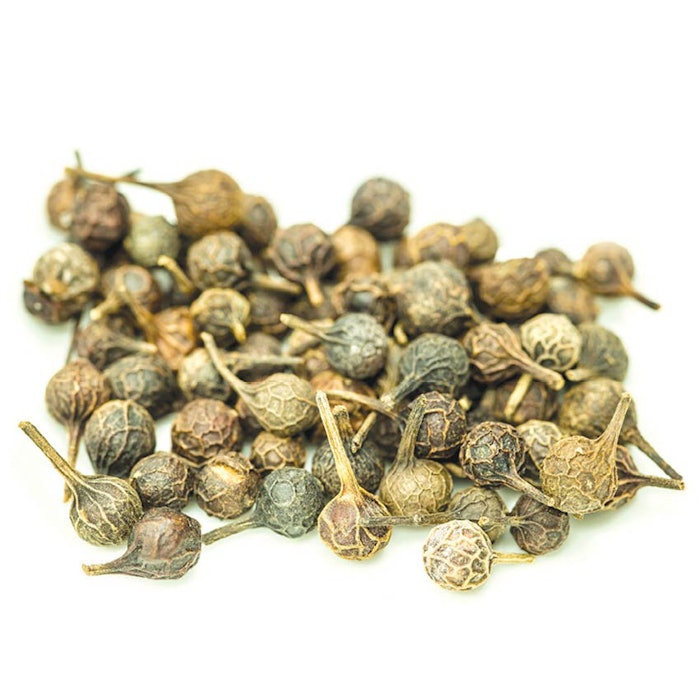
Cubeb oil is obtained by steam distillation of the dried fruit (berries) of Piper cubeba L. (sometimes known as tailed pepper or Java pepper), a member of the Piperaceae family. Piper cubeba is a perennial, woody, dioecious, climbing vine that is mostly grown in Java and Sumatra. The vine possesses slightly aromatic leaves and aromatic globose, berry-like fruit which are borne on a spike similar to black pepper. It is estimated that 5–6 metric tonnes of cubeb oil are produced annually in Indonesia.
Log in to view the full article
Cubeb oil is obtained by steam distillation of the dried fruit (berries) of Piper cubeba L. (sometimes known as tailed pepper or Java pepper), a member of the Piperaceae family. Piper cubeba is a perennial, woody, dioecious, climbing vine that is mostly grown in Java and Sumatra. The vine possesses slightly aromatic leaves and aromatic globose, berry-like fruit which are borne on a spike similar to black pepper. It is estimated that 5–6 metric tonnes of cubeb oil are produced annually in Indonesia.
A survey of the published reviews on cubeb oil (Lawrence, 1980, 2001, 2009) revealed that the constituents that were unequivocally characterized in this oil, listed in elution order from a non-polar capillary GC column, were as follows:
α -thujene (< 0.1–2.5%)
α -pinene (0.3–7.9%)
sabinene (0.7–29.6%)
β -pinene (< 0.1–0.2%)
myrcene (< 0.1–1.7%)
α -terpinene (< 0.1–1.3%)
p-cymene (< 0.1–1.1%)
limonene (0.1–4.4%)
1,8-cineole (0.3–0.8%)
β -phellandrene (< 0.1–0.8%)
γ -terpinene (0.1–0.7%)
(E)-β -ocimene (< 0.1–0.1%)
cis-sabinene hydrate (< 0.1–0.4%)
terpinolene (< 0.1–0.3%)
linalool (< 0.1–1.0%)
borneol (< 0.1–0.3%)
terpinen-4-ol (0.1–2.7%)
p-cymen-8-ol (0.1–0.3%)
α -terpineol (0.1–2.8%)
cuminaldehyde (< 0.1–0.2%)
δ -elemene (0.1–0.3%)
α -cubebene (1.5–5.7%)
cyclosativene (< 0.1–0.2%)
safrole (< 0.1–0.1%)
α -copaene (3.8–14.3%)
β -cubebene (0.2–11.1%)
β -elemene (1.0–9.4%)
β -caryophyllene (1.1–9.5%)
trans-α -bergamotene (< 0.1–0.2%)
α -humulene (0.5–0.9%)
(E)-β -farnesene (< 0.1–0.2%)
allo-aromadendrene (0.2–11.0%)
γ -muurolene (< 0.1–11.5%)
germacrene D (0.1–11.1%)
epi-cubebol (< 0.1–4.6%)
α -muurolene (0.6–1.7%)
β -bisabolene (1.5–2.0)
γ -cadinene (0.1–0.3%)
cubebol (5.6–30.9%)
cis-calamenene (1.0–3.8%)
δ -cadinene (< 0.1–9.5%)
cadina-1, 4-diene (< 0.1–0.2%)
myristicin (< 0.1–0.1%)
(E)-nerolidol (0.1–3.6%)
ledol (< 0.1–0.2%)
caryophyllene oxide (< 0.1–0.1%)
globulol (< 0.1–3.5%)
dillapiole (< 0.1–0.2%)
1-epi-cubenol (0.3–3.5%)
T-muurolol (< 0.1–0.3%)
α -cadinol (0.2–1.0%)
(E)-asarone (0.9–3.7%)
apiole (< 0.1–0.2%)
An oil produced from the dried fruit of P. cubeba, which was purchased at a local market in Trivandrum (Kerala, India), was produced by hydrodistillation in the laboratory by Sumathykutty et al. (1999). Analysis of this oil by GC-FID and GC/MS revealed that it possessed the following composition:
α -pinene (2.2%)
β -pinene (18.2%)
α -phellandrene (0.2%)
δ -3-carene (0.3%)
p-cymene (0.4%)
limonene (2.0%)
γ -terpinene (0.7%)
linalool oxide*f (1.4%)
terpinolene (0.2%)
linalool (1.5%)
myrcenol (0.6%)
dihydrolinalool† (0.1%)
camphor (0.1%)
borneol (0.1%)
terpinen-4-ol (0.1%)
α -terpineol (1.7%)
safrole (0.1%)
thymol (0.1%)
citronellyl acetate (0.5%)
methyl eugenol (2.3%)
α -copaene (0.9%)
β -elemene (7.3%)
β -cubebene (5.6%)
β -caryophyllene (0.4%)
β -copaene (3.3%)
(E)-β -farnesene (0.1%)
α -humulene (0.3%)
allo-aromadendrene (2.3%)
germacrene D (1.5%)
β -bisabolene (3.1%)
δ -cadinene (4.7%)
cubebol (23.6%)
caryophyllene oxide (1.3%)
guaiol (1.0%)
isocedrol (0.2%)
cedrol (0.3%)
β -eudesmol (2.4%)
α -cadinol (0.9%)
β -bisabolol (1.0%)
(Z, Z)- farnesol (0.6%)
(E, Z) - farnesol (0.1%)
*correct isomer not identified
f furanoid form
†does not occur naturally
In addition, trace amounts (< 0.05%) of α -thujene, 1,4-cineole, (E)-β -ocimene, α -fenchyl alcohol, trans-carveol, neral, geraniol, geranial, a sabinyl acetate isomer, α -terpinyl acetate, β -cedrene, cedrene epoxide, (Z, E)- farnesol and (E, E)- farnesol were also characterized in this oil.
Dried P. cubeba berries that were purchased from a local market in Gorakhpur (Uttar Pradesh, India) were ground to 100 mesh and subjected to 4hr hydrodistillation to yield a colorless oil in 2.3% yield. Analysis of the oil using GC-FID and GC/MS by Singh et al. (2007) revealed that the oil possessed the following composition:
α -thujene (4.5%)
α -pinene (4.1%)
sabinene (19.4%)
β -pinene (0.7%)
myrcene (0.3%)
α -phellandrene (0.2%)
p-cymene (1.0%)
β -phellandrene (5.9%)
γ -terpinene (0.2%)
cis-sabinene hydrate (0.9%)
trans-sabinene hydrate (0.5%)
linalool (4.9%)
terpinene-4-ol (0.9%)
δ -elemene (0.3%)
α -cubebene (4.1%)
α -copaene (8.8%)
β -cubebene (18.3%)
β -elemene (0.6%)
α -gurjunene (0.3%)
β -caryophyllene (3.7%)
aromadendrene (0.1%)
α -guaiene (0.2%)
α -humulene (0.9%)
allo-aromadendrene (3.1%)
γ -amorphene (2.0%)
germacrene D (2.6%)
zingiberene (0.1%)
bicyclogermacrene (1.5%)
cubebol*(0.2%)
α -muurolene (0.6%)
cubebol (4.7%)
γ -cadinene (0.9%)
trans-cadina-1(2), 4-diene (0.2%)
germacrene D (0.1%)
spathulenol (0.4%)
caryophyllene oxide (0.3%)
viridiflorol (0.3%)
*correct isomer not identified
In addition, trace amounts (< 0.1%) of camphene, δ -3-carene, α -terpinene, 1,8-cineole, terpinolene, camphor and isoledene were also characterized in this oil.
Singh et al. (2008) purchased a second lot of P. cubeba berries from the same local market. These in turn were hydrodistilled after grinding to yield an oil that was subjected to analysis using GC-FID and GC/MS. This oil was found to contain, the following:
α -thujene (1.9%)
α -pinene (1.9%)
sabinene (9.6%)
β -pinene (0.6%)
myrcene (0.2%)
α -phellandrene (0.1%)
p-cymene (0.4%)
limonene (0.5%)
β -phellandrene (1.7%)
1,8-cineole (1.3%)
γ -terpinene (0.1%)
cis-sabinene hydrate (0.7%)
linalool (3.2%)
δ -terpineol (0.6%)
camphor (0.1%)
terpinen-4-ol (1.0%)
α -terpineol (0.3%)
δ -elemene (0.1%)
α -cubebene (3.9%)
α -copaene (7.4%)
geranyl acetate (0.1%)
β -cubebene (18.9%)
β -elemene (1.4%)
α -gurjunene (0.7%)
cis-α -bergamotene (0.3%)
β -caryophyllene (5.3%)
aromadendrene (0.1%)
α -guaiene (0.1%)
α -humulene (2.0%)
allo-aromadendrene (4.1%)
cadina-1(6), 4-diene (0.1%)
γ -muurolene (2.4%)
germacrene D (4.7%)
β -selinene (0.6%)
trans-muurola-4(14),5-diene (0.8%)
bicyclogermacrene (1.5%)
4-epi-cubebol (1.9%)
α -muurolene (0.6%)
germacrene A (0.2%)
cubebol (13.3%)
δ -cadinene (0.2%)
cis-calamenene (0.7%)
germacrene B (0.3%)
(E)-nerolidol (0.7%)
spathulenol (0.5%)
caryophyllene oxide (0.6%)
gleenol (0.1%)
viridiflorol (0.3%)
1-epi-cubenol (0.4%)
isospathulenol (0.1%)
Trace amounts (< 0.1%) of camphene, δ -3-carene, α -terpinene, terpinolene, borneol, cryptone, cuminaldehyde and isoledene were also characterized in this oil. The authors also produced extracts of the same batch of cubeb using diethyl ether, ethanol, petroleum-benzene, chloroform and methanol. The volatiles in amounts of 0.1% or greater characterized in these extracts are listed in T-1.
The percentage volatiles in each of the extracts was 79.6% (diethyl ether), 83.0% (ethanol), 86.6% (petroleum-benzene), 70.1% (chloroform) and 53.4% (methanol).
An oil of P. cubeba that was produced in 1.7% yield by Ismaniar (2013) was analyzed using GC/MS as the method of analysis. The oil was found to contain sativene (8.7%), spathulenol (27.1%), and germacrene D (7.5%) as major constituents.










